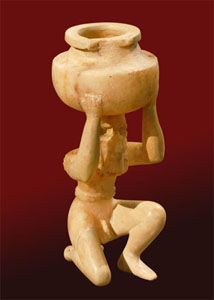Significance of Excavations: Located in the lower Diyala river basin northeast of Baghdad, excavations at the sites of Tell Agrab, Tell Asmar (ancient Eshnunna), Ishchali (ancient Neribtum), and Khafaje (ancient Tutub), have provided some of the most comprehensive data for Mesopotamian archaeology and chronology. Undertaken by the University of Chicago‚ Oriental Institute (1930-1937) and by the University of Pennsylvania (1938-1939), these projects were of an unprecedented scale. Up to 25% of the total area of each site were excavated, uncovering not only the remains of palaces and temples, but also of houses, manufacturing facilities, streets, and urban defensive systems, with some soundings extending as deep as 16 meters below the mounds‚present surfaces. Covering the time between the late Uruk period and the end of the Old Babylonian period (3000-1700 BC), the Diyala material represents a crucial part of Mesopotamia's early history during which large territorial states emerged, cities grew to unprecedented sizes, and the cuneiform writing system emerged.
[Description from the DiyArDa Project]
Preliminary Reports
Final Reports
- OIC 20. Progress of the Work of the Oriental Institute in Iraq, 1934/35: Fifth Preliminary Report of the Iraq Expedition. Henri Frankfort. 1936.
- OIC 19. Oriental Institute Discoveries in Iraq, 1933/34: Fourth Preliminary Report of the Iraq Expedition. Henri Frankfort, with a chapter by Thorkild Jacobsen. 1935.
- OIC 17. Iraq Excavations of the Oriental Institute 1932/33: Third Preliminary Report of the Iraq Expedition. Henri Frankfort. 1934.
- OIC 16. Tell Asmar, Khafaje and Khorsabad: Second Preliminary Report of the Iraq Expedition. Henri Frankfort. 1933.
- OIC 13. Tell Asmar and Khafaje: The First Season’s Work in Eshnunna 1930/31. Henri Frankfort, Thorkild Jacobsen, and Conrad Preusser. 1932.
- OIP 98. Old Babylonian Public Buildings in the Diyala Region. Part One: Excavations at Ishchali, Part Two: Khafajah Mounds B, C, and D. H. D. Hill, et. al. 1990.
- OIP 88. Private Houses and Graves in the Diyala Region. Pinhas Delougaz, Harold D. Hill, and Seton Lloyd. 1967.
- OIP 72. Stratified Cylinder Seals from the Diyala Region. Henri Frankfort with a chapter by Thorkild Jacobsen. 1955.
- OIP 63. Pottery from the Diyala Region. Pinhas Delougaz. 1952.
- OIP 60. More Sculpture from the Diyala Region. Henri Frankfort. 1943.
- OIP 58. Pre-Sargonid Temples in the Diyala Region. Pinhas Delougaz and Seton Lloyd with chapters by Henri Frankfort and Thorkild Jacobsen. 1942.
- OIP 53. The Temple Oval at Khafajah. Pinhas Delougaz, with a chapter by Thorkild Jacobsen. 1940
- OIP 44. Sculpture of the Third Millennium B.C. from Tell Asmar and Khafajah. Henri Frankfort. 1939.
- OIP 43. The Gimilsin Temple and the Palace of the Rulers at Tell Asmar. Henri Frankfort, Seton Lloyd, and Thorkild Jacobsen, with a chapter by Günter Martiny. 1940.
Philological Reports
- MAD 1. Sargonic Texts from the Diyala Region I. J. Gelb., 1952.
- AS 22. Old Babylonian Letters from Tell Asmar. R. M. Whiting, Jr. 1987.
- AS 6. Philological Notes on Eshnunna and Its Inscriptions. Thorkild Jacobsen. Originally published in 1934.
See also the
And for an up to date list of all Oriental Institute publications available online see










 Stumble It!
Stumble It!

No comments:
Post a Comment